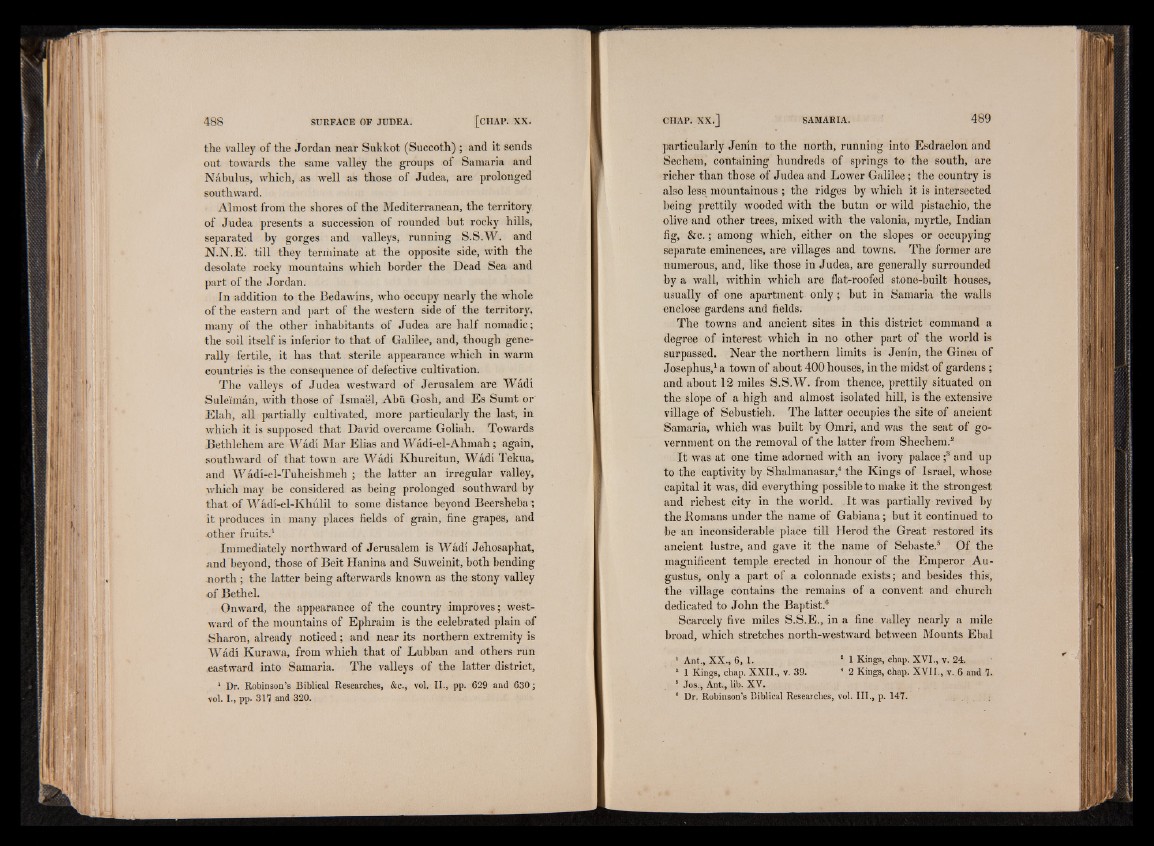
the valley of the Jordan near Sukkot (Succoth) ; and it sends
out towards the same valley the groups of Samaria and
Nabulus, which, as well as those of Judea, are prolonged
southward.
Almost from the shores of the Mediterranean, the territory
of Judea presents a succession of rounded but rocky hills,
separated by gorges and valleys, running S.S.W. and
N.N.E. till they terminate at the opposite side, with the
desolate rocky mountains which border the Dead Sea and
part of the Jordan.
In addition to the Bedawins, who occupy nearly the whole
of the eastern and part of the western side of the territory,
many of the other inhabitants of Judea are halt nomadic;
the soil itself is inferior to that of Galilee, and, though generally
fertile, it has that sterile appearance which in warm
countries is the consequence of defective cultivation.
The valleys of Judea westward of Jerusalem are Wadi
Suleiman, with those of Ismael, Abu Gosh, and Es Sumt or
Elah, all partially cultivated, more particularly the last, in
which it is supposed that David overcame Goliah. Towards
Bethlehem are Wadi Mar Elias and Wadi-el-Ahinah; again,
southward of that town are Wadi Khureitun, Wadi Tekua,
and Wadi-el-Tuheishmeh ; the latter an irregular valley,
which may be considered as being prolonged southward by
that of Wadi-el-Khulil to some distance beyond Beersheba;
it produces in many places fields of grain, fine grapes, and
other fruits.1
Immediately northward of Jerusalem is Wadi Jehosaphat,
and beyond, those of Beit Hanina and Suweinit, both bending
north; the latter being afterwards known as the stony valley
of Bethel.
Onward, the appearance of the country improves; westward
of the mountains of Ephraim is the celebrated plain of
Sharon, already noticed; and near its northern extremity is
Wadi Kurawa, from which that of Lubban and others run
.eastward into Samaria. The valleys of the latter district,
1 Dr. Robinson’s Biblical Researches, &c., vol. II., pp. 629 and 630;
vol. I., pp. 311 and 320.
particularly Jenin to the north, running into Esdraelon and
Sechem, containing hundreds of springs to the south, are
richer than those of Judea and Lower Galilee; the country is
also less_ mountainous ; the ridges by which it is intersected
being prettily wooded with the butm or wild pistachio, the
olive and other trees, mixed with the valonia, myrtle, Indian
fig, &c.; among which, either on the slopes or occupying
separate eminences, are villages and towns. The former are
numerous, and, like those in Judea, are generally surrounded
by a wall, within which are flat-roofed stone-built houses,
usually of one apartment only; but in Samaria the walls
enclose gardens and fields.
The towns and ancient sites in this district command a
degree of interest which in no other part of the world is
surpassed. Near the northern limits is Jenin, the Ginea of
Josephus,1 a town of about 400 houses, in the midst of gardens;
and about 12 miles S.S.W. from thence, prettily situated on
the slope of a high and almost isolated hill, is the extensive
village of Sebustieh. The latter occupies the site of ancient
Samaria, which was built by Omri, and was the seat of government
on the removal of the latter from Shechem/2
It was at one time adorned with an ivory palace ;s and up
to the captivity by Shalmanasar,4 the Kings of Israel, whose
capital it was, did everything possible to make it the strongest
and richest city in the world. It was partially revived by
the Romans under the name of Gabiana; but it continued to
be an inconsiderable place till Herod the Great restored its
ancient lustre, and gave it the name of Sebaste.5 Of the
magnificent temple erected in honour of the Emperor Augustus,
only a part of a colonnade exists; and besides this,
the village contains the remains of a convent and church
dedicated to John the Baptist.6
Scarcely five miles S.S.E., in a fine valley nearly a mile
broad, which stretches north-westward between Mounts Ebal
1 Ant., XX., 6, 1. 8 1 Kings, chap. XVI., v. 24.
s 1 Kings, chap. XXII., v. 39. 4 2 Kings, chap. XVII., v. 6 and 7-
s Jos., Ant., lib. XV.
6 Dr. Robinson’s Biblical Researches, vol. III., p. 147.